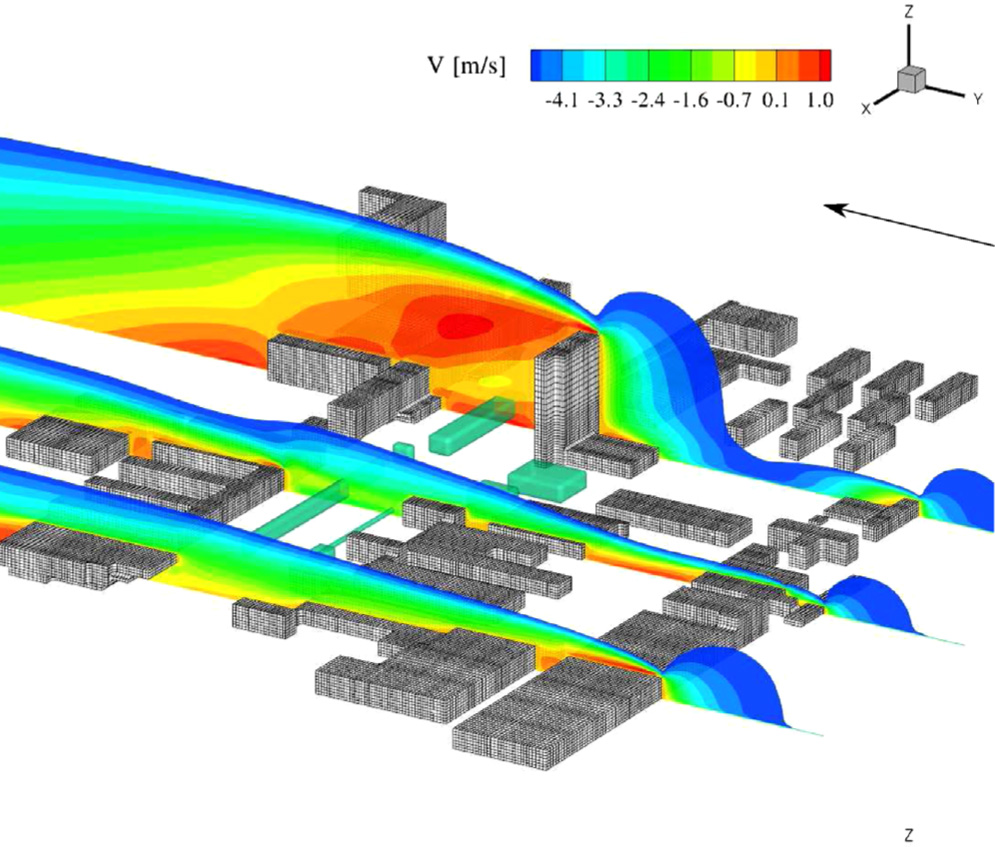A new mathematical model developed by Dr. Sasa Kenjeres and colleagues shows that more trees on the campus would reduce wind nuisance around the EWI-building considerably.
The storm of 28 October was well timed for Dr. Kenjeres (Associate Professor at the faculty of Applied Sciences (TNW), Department of Chemical Engineering, Transport Phenomena Section, and Burgers Centre for Fluid Dynamics) and Benjamin ter Kuile MSc. (from Uflows, Delft). They had just published an article on the modeling and simulation of turbulent flows in urban areas for the Journal of Wind Engineering and Industrial Aerodynamics.
Kenjeres has been developing a computational model for the spread of smoke or chemical pollution on street level. Why so precise? Because drafts and whirl winds can result in changes of the local concentrations. When you want to know how pollution spreads,the first thing to get straight is the accurate flow prediction, he says. But because of the complex geometry of the built environment, calculating the flow with classic Navier-Stokes equations soon gets way too complex.
“We have developed a mathematical model of turbulence which accurately predicts intensity of air flow fluctuations in presence of vegetation”, Kenjeres says about so-called Reynolds-averaged Navier-Stokes approach.
Take the influence of trees on the wind flow for example. On a small scale they cause extra eddies in the air stream that result in additional fluctuations. But they will also reduce the general wind speed. Two equations describe the production and the dissipation of turbulence, driven both by mechanisms that grow or dampen instabilities in the flow. The Reynolds-averaged Navier-Stokes approach will give you the total contribution of fluctuations.
As a proof of principle, Kenjeres and his MSc student Benjamin ter Kuile have modeled the wind over the TU Delft campus with a 3D-grid that represents the main buildings, including the EWI-building that has a reputation of enhancing strong winds. They compared the current situation with a ‘new’ situation in which additional trees are planted behind and next to the EWI building to reduce the wind effects and an ‘old’ situation which mimics the current situation at the campus.


Old & new
Their model shows that trees reduce the cross wind at EWI considerably. If the initial wind speed is 5 meter per second, without trees the draft at EWI measures up to 4 meter per second. In the current situation it is 3,5 m/s, but with additional trees will reduce the wind speed to under2 m/s.
Of course, trees in a storm are a risky environment – three people got killed by falling trees or branches during the 28 October storm. So, how sensible is it then to plant trees all over the campus? Kenjeres says that a serious wind defense would include not only trees on the campus, but additional buffer layers further upwind , that would prevent dangerous wind speeds on the campus.
The urban airflow model that runs on a standard PC could be used for predicting the spread of a smoke cloud (think of the large fire at Chemiepak next to the village of Moerdijk for example), for mapping the most critical city zones for traffic pollution of for pre-planning the wind-effects of buildings by city planners.
If, for example. the current software had been available at the time, it is unlikely that the EWI building had been put on its current spot. With the prevailing south-east wind, it would have made more sense to turn the building by 90 degrees.



Comments are closed.